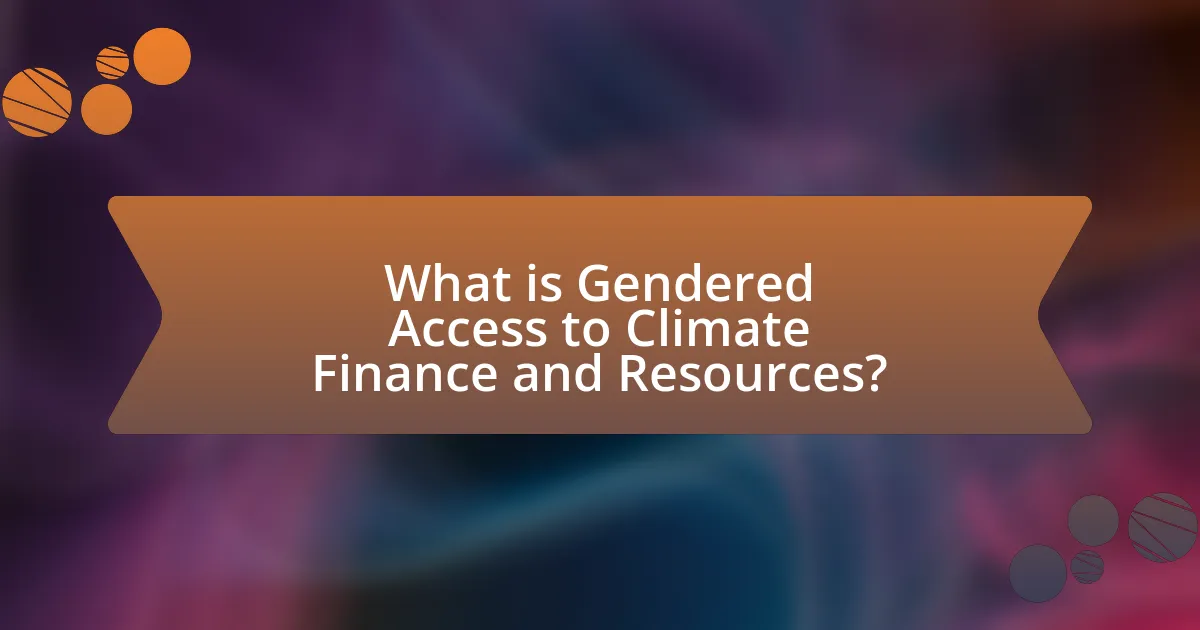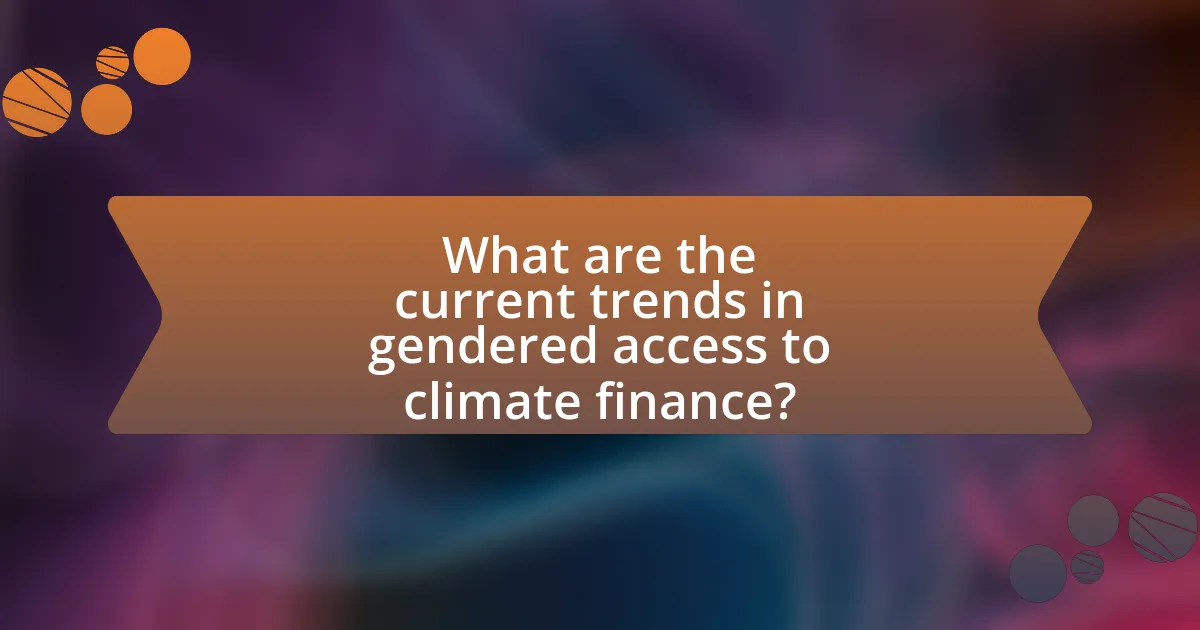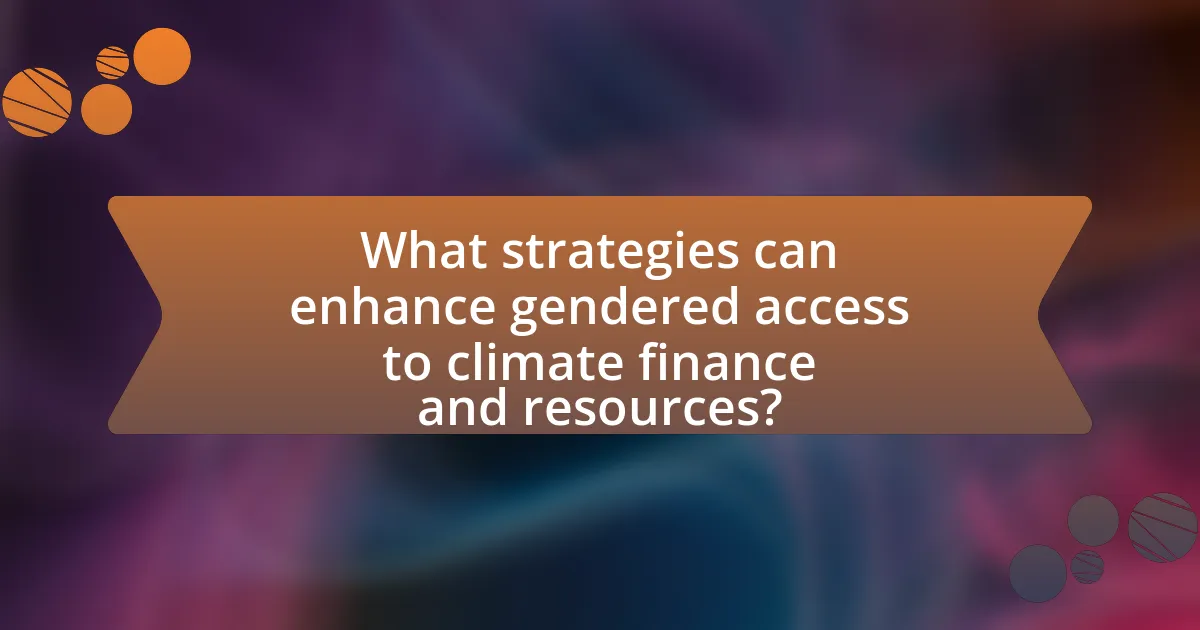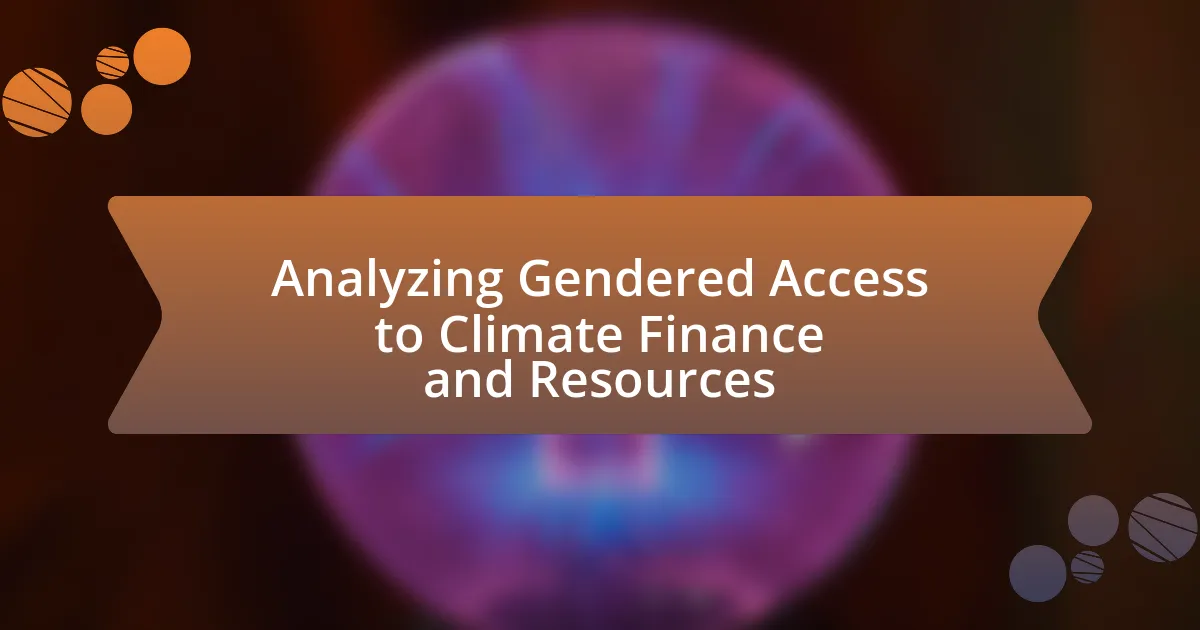Gendered access to climate finance and resources highlights the disparities faced by women in obtaining financial support for climate-related initiatives. The article examines how systemic barriers, such as limited financial literacy and cultural norms, restrict women’s participation in climate finance decision-making processes. It discusses the implications of unequal access for climate action, emphasizing the need for gender-responsive financing mechanisms to enhance community resilience and sustainability. Additionally, the article explores current trends, policy evolution, and strategies to improve gender equity in climate finance, underscoring the importance of grassroots organizations and capacity-building efforts in empowering women.

What is Gendered Access to Climate Finance and Resources?
Gendered access to climate finance and resources refers to the disparities in the ability of different genders, particularly women, to access financial resources and support for climate-related initiatives. Research indicates that women often face systemic barriers, such as lack of collateral, limited financial literacy, and cultural norms, which hinder their access to climate finance. For instance, the United Nations Development Programme (UNDP) highlights that women are disproportionately affected by climate change yet receive only a fraction of climate finance, illustrating the need for gender-responsive financing mechanisms to ensure equitable access.
How does gender influence access to climate finance?
Gender significantly influences access to climate finance by creating disparities in eligibility and participation in funding opportunities. Women often face systemic barriers such as limited access to information, financial resources, and decision-making power, which restrict their ability to engage with climate finance mechanisms. For instance, a study by the Global Gender and Climate Alliance found that women represent only 30% of participants in climate finance decision-making processes, highlighting the gender gap in access. Additionally, gender-responsive climate finance initiatives have been shown to improve project outcomes and community resilience, as evidenced by the success of programs that specifically target women’s involvement in climate adaptation and mitigation efforts.
What are the barriers women face in accessing climate finance?
Women face several barriers in accessing climate finance, including systemic gender biases, lack of financial literacy, and limited access to networks. Systemic gender biases often result in women being overlooked for funding opportunities, as decision-makers may favor male-led initiatives. Additionally, many women lack the financial literacy required to navigate complex funding applications, which can hinder their ability to secure resources. Limited access to professional networks further exacerbates these challenges, as women may not have the same connections as their male counterparts to learn about or access available funding. According to a report by the Global Gender and Climate Alliance, these barriers significantly restrict women’s participation in climate finance, ultimately impacting their ability to contribute to climate resilience and adaptation efforts.
How do societal norms impact women’s access to climate resources?
Societal norms significantly restrict women’s access to climate resources by perpetuating gender inequalities that limit their participation in decision-making processes. In many cultures, traditional roles assign women responsibilities for household management and caregiving, which often excludes them from engaging in climate-related initiatives or accessing financial resources. For instance, a study by the World Bank indicates that women are less likely to own land or have access to credit, which are crucial for climate adaptation strategies. Furthermore, societal expectations can discourage women from seeking leadership roles in environmental organizations, thereby diminishing their influence in climate resource allocation. These norms create barriers that hinder women’s ability to effectively respond to climate challenges, ultimately impacting community resilience and sustainability.
Why is analyzing gendered access to climate finance important?
Analyzing gendered access to climate finance is important because it reveals disparities in resource allocation that can hinder effective climate action. Women often face systemic barriers that limit their access to financial resources, which are crucial for implementing climate adaptation and mitigation strategies. For instance, a study by the Global Gender and Climate Alliance found that women represent only 30% of participants in climate finance decision-making processes, leading to underfunded initiatives that address their specific needs. This analysis is essential for promoting equitable and inclusive climate policies that enhance resilience and sustainability for all communities.
What are the implications of unequal access for climate action?
Unequal access to climate finance and resources significantly hampers effective climate action, particularly for marginalized groups, including women. This disparity leads to a lack of representation in decision-making processes, resulting in policies that do not address the specific needs of these groups. For instance, the Global Gender and Climate Alliance reports that women, who are often the primary managers of natural resources, face barriers in accessing funding and resources necessary for climate adaptation and mitigation. Consequently, this inequity exacerbates vulnerabilities to climate impacts, undermines community resilience, and limits the overall effectiveness of climate initiatives.
How does gendered access affect community resilience to climate change?
Gendered access significantly affects community resilience to climate change by influencing the distribution of resources and decision-making power. Women often face barriers in accessing financial resources, land, and information, which limits their ability to adapt to climate impacts. For instance, a study by the Food and Agriculture Organization (FAO) found that when women have equal access to resources, agricultural productivity can increase by 20-30%, enhancing food security and community resilience. Furthermore, women’s involvement in climate decision-making leads to more comprehensive and effective strategies, as evidenced by research from the United Nations Development Programme (UNDP), which highlights that inclusive governance improves adaptive capacity. Thus, addressing gendered access is crucial for strengthening community resilience to climate change.

What are the current trends in gendered access to climate finance?
Current trends in gendered access to climate finance indicate a growing recognition of the importance of integrating gender considerations into climate funding mechanisms. Research shows that women often face barriers in accessing climate finance due to systemic inequalities, but initiatives are emerging to address these gaps. For instance, the Green Climate Fund has implemented gender-sensitive policies, requiring projects to demonstrate how they will benefit women and promote gender equality. Additionally, studies reveal that countries with gender-responsive climate policies are more likely to secure funding, highlighting the correlation between gender equity and access to climate finance.
How have policies evolved regarding gender and climate finance?
Policies regarding gender and climate finance have evolved to increasingly recognize the importance of integrating gender considerations into climate finance mechanisms. Initially, climate finance policies largely overlooked gender disparities, focusing primarily on environmental outcomes. However, recent frameworks, such as the Paris Agreement and the Gender Action Plan established by the UNFCCC, emphasize the need for gender-responsive climate finance, highlighting that women are disproportionately affected by climate change and play crucial roles in climate resilience and adaptation.
Evidence of this evolution is seen in the establishment of dedicated funding streams aimed at empowering women in climate initiatives, such as the Green Climate Fund’s Gender Policy, which mandates that projects consider gender impacts and promote gender equality. Additionally, research indicates that gender-inclusive policies can enhance the effectiveness of climate finance, as women often possess unique knowledge and skills that contribute to sustainable practices.
What role do international agreements play in promoting gender equity?
International agreements play a crucial role in promoting gender equity by establishing frameworks that mandate the inclusion of gender considerations in policy-making and resource allocation. For instance, the Convention on the Elimination of All Forms of Discrimination Against Women (CEDAW) requires signatory countries to take appropriate measures to eliminate discrimination against women, thereby influencing national laws and practices. Additionally, the Paris Agreement emphasizes the importance of gender equality in climate action, encouraging countries to integrate gender perspectives into their climate policies and funding mechanisms. These agreements create accountability and provide guidelines that help ensure women’s rights and participation are prioritized in various sectors, including climate finance and resource management.
How are funding mechanisms adapting to address gender disparities?
Funding mechanisms are adapting to address gender disparities by implementing gender-responsive budgeting and prioritizing investments in women-led initiatives. For instance, the Green Climate Fund has established a Gender Policy that mandates the integration of gender considerations into funding proposals, ensuring that projects actively promote gender equality. Additionally, research from the United Nations Development Programme indicates that gender-responsive climate finance can enhance resilience and empower women, leading to more effective climate action. These adaptations reflect a growing recognition of the importance of gender equity in achieving sustainable development goals.
What data is available on gendered access to climate resources?
Data on gendered access to climate resources indicates significant disparities between men and women in accessing financial and natural resources for climate adaptation and mitigation. Research by the Global Gender and Climate Alliance reveals that women, particularly in developing countries, often have less access to climate finance, with only 1% of climate funding reaching women-led initiatives. Additionally, the United Nations Development Programme reports that women are disproportionately affected by climate change impacts, which limits their ability to access resources necessary for resilience. This data underscores the need for gender-sensitive approaches in climate policy to ensure equitable access to resources.
What are the key indicators used to measure gendered access?
Key indicators used to measure gendered access include participation rates in decision-making processes, access to financial resources, and ownership of assets. These indicators assess the extent to which women and marginalized genders engage in climate finance and resource allocation. For instance, studies show that women’s participation in climate-related decision-making can lead to more equitable outcomes, as evidenced by the 2019 UN report highlighting that countries with higher female representation in climate policy bodies tend to allocate resources more effectively towards gender-responsive initiatives. Additionally, access to financial resources is often quantified through metrics such as credit availability and loan approval rates for women entrepreneurs, which directly impacts their ability to invest in sustainable practices.
How can data gaps be addressed to improve understanding?
Data gaps can be addressed by implementing comprehensive data collection strategies that focus on gender-disaggregated data in climate finance and resource allocation. This approach enhances understanding by revealing disparities in access and utilization of resources between genders. For instance, the Global Gender and Climate Alliance emphasizes the importance of collecting data that reflects the specific needs and contributions of women in climate initiatives, which can lead to more equitable policy-making. Additionally, integrating qualitative research methods, such as interviews and focus groups, can provide deeper insights into the lived experiences of different gender groups, further illuminating the nuances of access to climate finance.

What strategies can enhance gendered access to climate finance and resources?
Strategies that can enhance gendered access to climate finance and resources include implementing gender-responsive budgeting, promoting women’s leadership in climate initiatives, and ensuring equitable access to information and training. Gender-responsive budgeting allocates financial resources in a way that addresses the specific needs of women, thereby increasing their participation in climate-related projects. Promoting women’s leadership ensures that their perspectives and needs are integrated into decision-making processes, which has been shown to improve project outcomes. Additionally, providing equitable access to information and training empowers women with the skills and knowledge necessary to engage effectively with climate finance mechanisms. Research indicates that when women are actively involved in climate finance, projects are more likely to succeed and have lasting impacts on communities.
How can stakeholders promote gender equity in climate finance?
Stakeholders can promote gender equity in climate finance by implementing gender-responsive budgeting and ensuring equal access to funding opportunities for women-led initiatives. Research indicates that women are disproportionately affected by climate change, yet they often lack access to financial resources necessary for adaptation and mitigation efforts. For instance, the Global Gender and Climate Alliance highlights that integrating gender considerations into climate finance mechanisms can enhance the effectiveness of climate actions and empower women economically. By prioritizing gender equity in funding allocations and decision-making processes, stakeholders can create a more inclusive and effective climate finance landscape.
What best practices exist for integrating gender into climate finance initiatives?
Best practices for integrating gender into climate finance initiatives include ensuring gender-responsive budgeting, promoting women’s participation in decision-making processes, and implementing gender-sensitive monitoring and evaluation frameworks. Gender-responsive budgeting allocates resources in a way that addresses the specific needs of women and men, thereby enhancing equity in climate finance. Promoting women’s participation ensures that their perspectives and experiences inform climate-related projects, leading to more effective outcomes. Additionally, gender-sensitive monitoring and evaluation frameworks track the impacts of climate finance on different genders, allowing for adjustments and improvements in future initiatives. These practices are supported by evidence from organizations like the United Nations Framework Convention on Climate Change, which emphasizes the importance of gender equality in achieving sustainable development goals.
How can capacity-building efforts support women’s access to resources?
Capacity-building efforts can enhance women’s access to resources by equipping them with the necessary skills, knowledge, and confidence to engage effectively in resource management and decision-making processes. For instance, training programs focused on financial literacy and entrepreneurship enable women to navigate financial systems and secure funding for their initiatives. Research indicates that when women receive targeted capacity-building support, such as in the case of the UN Women’s “Women’s Empowerment Principles,” they are more likely to access and control resources, leading to improved economic outcomes. This correlation is evidenced by studies showing that women who participate in capacity-building initiatives report increased access to financial resources and greater involvement in community resource management.
What role do grassroots organizations play in improving access?
Grassroots organizations play a crucial role in improving access to climate finance and resources by advocating for marginalized communities and ensuring their voices are heard in decision-making processes. These organizations mobilize local populations, raise awareness about climate issues, and facilitate access to funding opportunities tailored to community needs. For instance, a study by the International Institute for Environment and Development highlights that grassroots movements have successfully influenced policy changes that prioritize equitable resource distribution, demonstrating their effectiveness in bridging gaps in access.
How can local initiatives empower women in climate finance?
Local initiatives can empower women in climate finance by providing targeted training, access to resources, and creating networks that enhance their participation in financial decision-making. For instance, programs like the Women’s Climate Centers in various regions have successfully equipped women with skills in sustainable agriculture and renewable energy, enabling them to secure funding and investments for climate-resilient projects. Research shows that when women are involved in climate finance, there is a 20% increase in project effectiveness, as highlighted in the report by the Global Gender and Climate Alliance. This demonstrates that local initiatives not only foster women’s empowerment but also lead to more effective climate finance outcomes.
What success stories illustrate effective grassroots interventions?
Success stories illustrating effective grassroots interventions include the work of the Green Belt Movement in Kenya, which empowered women to plant over 51 million trees, enhancing environmental sustainability and community resilience. This initiative not only addressed deforestation but also provided women with income and leadership opportunities, demonstrating the impact of grassroots mobilization on climate action. Additionally, the Women’s Earth Alliance has successfully supported women-led projects in various countries, focusing on sustainable agriculture and clean energy, which have improved local economies and reduced carbon footprints. These examples highlight how grassroots interventions can effectively address climate challenges while promoting gender equity.
What are the challenges in implementing gender-responsive climate finance?
The challenges in implementing gender-responsive climate finance include inadequate data on gender-specific impacts, lack of gender-sensitive policies, and insufficient stakeholder engagement. Inadequate data hampers the ability to assess the unique needs of women and marginalized groups in climate finance, leading to ineffective allocation of resources. The absence of gender-sensitive policies results in a failure to address the specific vulnerabilities and contributions of women in climate adaptation and mitigation efforts. Furthermore, insufficient engagement with women and local communities limits their participation in decision-making processes, which is crucial for effective climate finance implementation. These challenges are documented in reports by organizations such as the United Nations Framework Convention on Climate Change, which highlights the need for targeted strategies to overcome these barriers.
How can resistance to change be overcome in funding institutions?
Resistance to change in funding institutions can be overcome by implementing inclusive decision-making processes that actively involve diverse stakeholders. Engaging various groups, particularly those historically marginalized, fosters a sense of ownership and reduces opposition to new initiatives. Research indicates that when funding institutions incorporate gender perspectives and ensure representation, they can enhance the effectiveness of climate finance strategies. For instance, the Global Environment Facility’s approach to integrating gender considerations has shown improved project outcomes and stakeholder buy-in, demonstrating that inclusive practices can effectively mitigate resistance to change.
What are the risks of tokenism in gendered climate finance initiatives?
Tokenism in gendered climate finance initiatives risks undermining genuine progress towards gender equality and effective climate action. This occurs when organizations superficially include women in decision-making processes without empowering them or addressing systemic barriers. For instance, a study by the Global Gender and Climate Alliance highlights that tokenistic approaches can lead to the marginalization of women’s voices, resulting in ineffective policies that do not reflect their needs or perspectives. Furthermore, tokenism can perpetuate stereotypes, as it often emphasizes women’s roles in climate adaptation rather than recognizing their potential as leaders and innovators in climate solutions. This ultimately hampers the effectiveness of climate finance initiatives and fails to achieve sustainable development goals.
What practical steps can be taken to improve gendered access to climate finance?
To improve gendered access to climate finance, implementing targeted capacity-building programs for women-led organizations is essential. These programs can enhance the skills and knowledge necessary for women to effectively navigate and access climate finance opportunities. Research indicates that women are often underrepresented in decision-making processes related to climate finance, which can be addressed by establishing gender-responsive policies that mandate the inclusion of women in climate finance governance. Additionally, creating dedicated funding streams for gender-specific climate initiatives can ensure that women’s unique needs and perspectives are prioritized. Evidence from the Global Gender and Climate Alliance shows that integrating gender considerations into climate finance mechanisms leads to more equitable outcomes and better project effectiveness.
